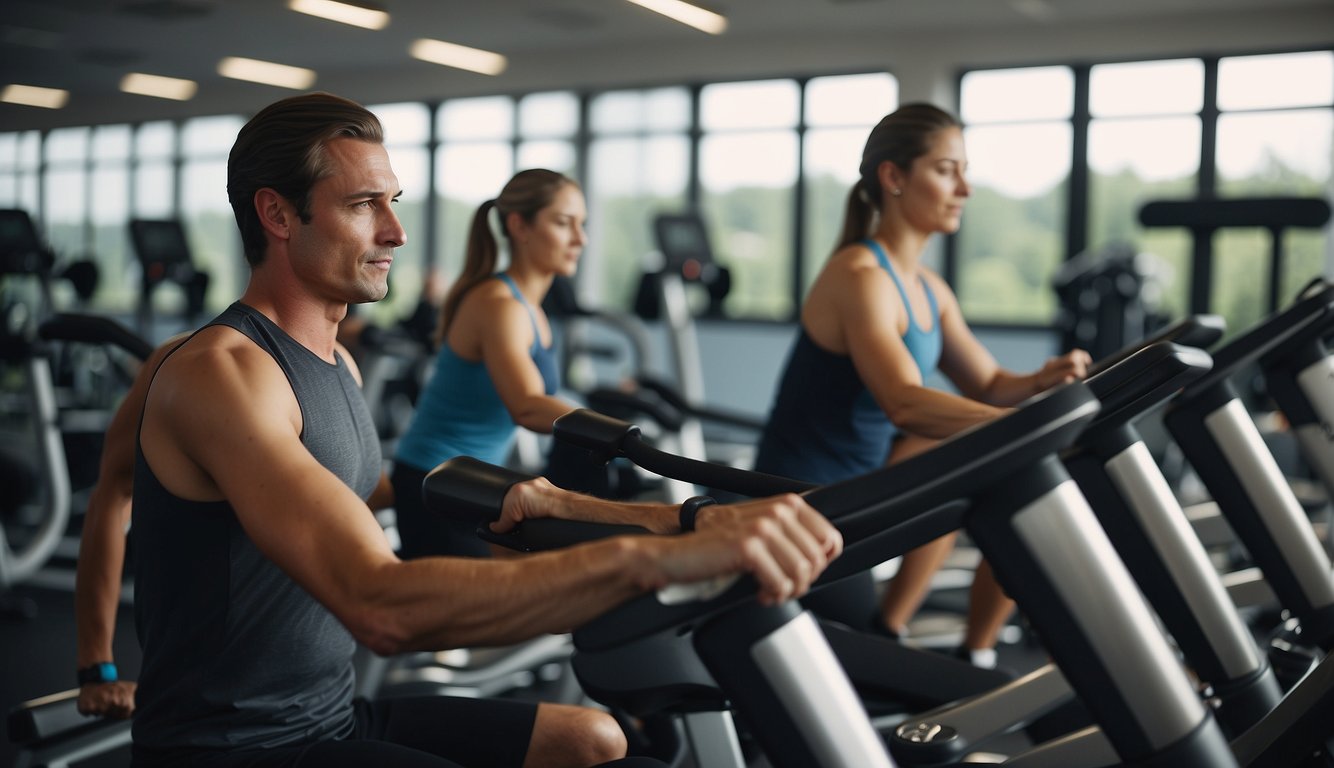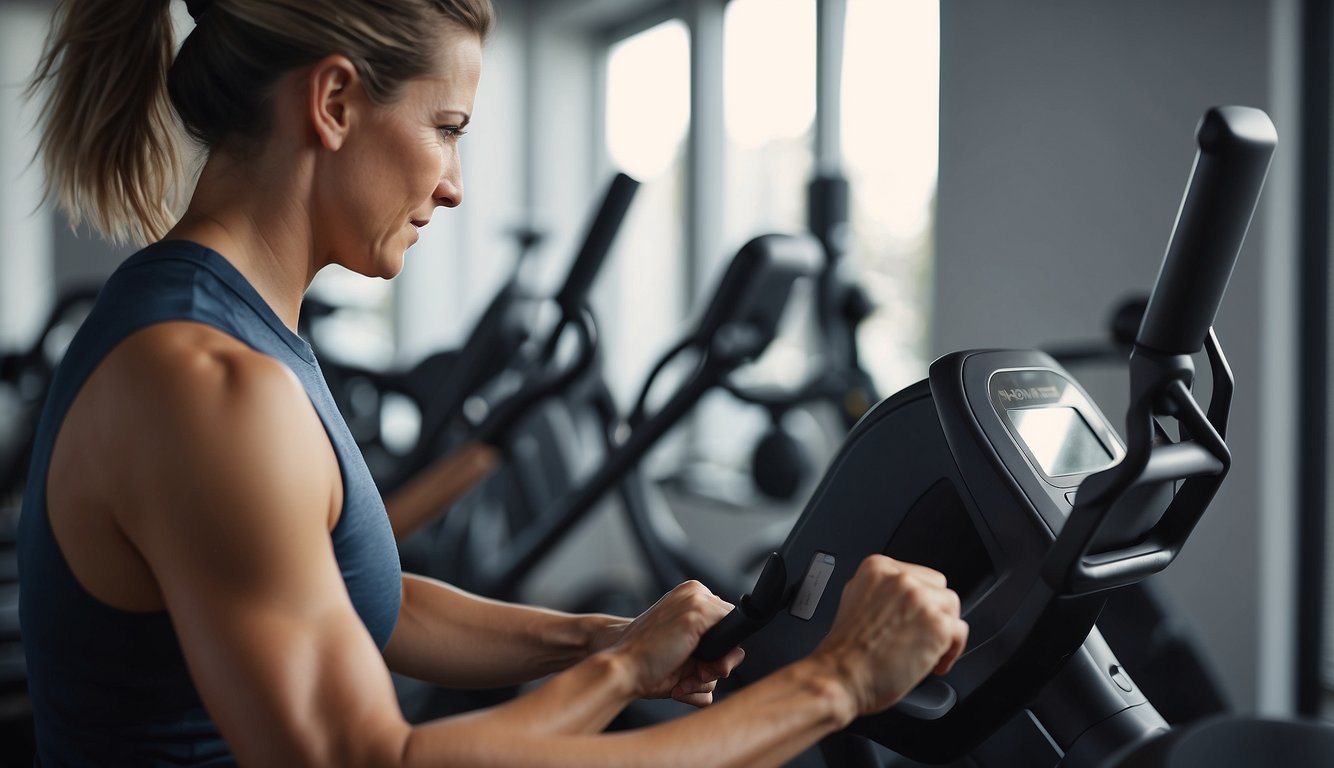When deciding to equip a home gym or simply identify the most effective cardiovascular machine for our fitness goals, the debate between a rowing machine and an exercise bike often emerges.
Both machines provide excellent cardio workouts, engage different muscle groups, and offer low-impact alternatives to high-intensity activities like running. We choose between these based on personal fitness levels, preferences, and the specific health outcomes we're aiming for.

Rowing machines harness our entire body, demanding effort from both the upper and lower body, making them superb for full-body workouts. On the other hand, exercise bikes focus primarily on the lower body, particularly the quadriceps, hamstrings, calves, and glutes.
Each machine has unique mechanisms and types, with variations like air or magnetic rowers and upright or recumbent bikes. Practical considerations also come into play, such as space availability in our home gyms and the adaptability of each machine to our fitness routines.
Key Takeaways
- Both rowing machines and exercise bikes deliver low-impact, high-result cardio workouts appealing to a range of fitness goals.
- Rowing machines offer a full-body workout engaging multiple muscle groups, while exercise bikes primarily target the lower body.
- We evaluate which machine best fits our home gym based on the space we have and our individual fitness preferences.
Types and Mechanisms of Rowing Machines and Exercise Bikes

When choosing between rowing machines and exercise bikes, it's important to understand their distinct mechanics and types. We’ll explore the basics of each, focusing particularly on their resistance mechanisms which are central to their operation and effectiveness.
Rowing Machine Basics
Rowing machines mimic the motion of rowing a boat, offering a full-body workout by engaging various muscle groups. The resistance in rowing machines can be categorised into four main types: air, magnetic, hydraulic, and water.
- Air resistance is generated by a flywheel that spins against air. It naturally adjusts to your effort—the harder you pull, the greater the resistance.
- Magnetic resistance uses electromagnets, allowing for a silent and smooth rowing experience. This type is often adjustable via a digital console.
- Hydraulic resistance operates through pistons, providing a compact option for those with limited space.
- Water resistance uses paddles suspended in a tank of water to provide a resistance that closely simulates real rowing on water.
Each type of resistance offers a different rowing experience, from the smooth, consistent pull of magnetic resistance to the natural feel of a water rower.
Exercise Bike Fundamentals
Exercise bikes, or stationary bikes, are a popular form of cycling that provides cardio exercise with minimal impact on the joints. They generally come in three types: upright, recumbent, and spin bikes.
- Upright bikes resemble a traditional bicycle, providing a workout that uses the body's weight to create resistance.
- Recumbent bikes feature a reclined body position that is easier on the lower back and optimises the user's comfort.
- Spin bikes are designed to mimic outdoor cycling experiences, enabling high-intensity workouts.
The resistance mechanism in exercise bikes can be friction-based, magnetic, or fan-based, with magnetic being most common in modern machines for its quiet operation and maintenance-free use. Users can easily adjust** the magnitude of resistance** to vary their workout intensity.
Physical Impact and Muscle Engagement

When comparing rowing machines and exercise bikes, it's paramount to understand how they impact the body and which muscle groups they target. Both options offer valuable workouts, but their muscle engagement is distinct.
Muscle Groups Targeted by Rowing Machines
Rowing is a comprehensive full-body workout that engages both the upper and lower body, encompassing a wide array of muscles. The primary muscles involved include:
- Core: Vital for stabilising the body during the catch and finish phases.
- Glutes and Hamstrings: Engaged during the drive phase to extend the hips.
- Quadriceps: Work during the drive phase as you push off against the footplate.
- Upper Body: The back, shoulders, and arms are utilised for pulling the handle towards the torso.
For those with paraplegia, specialised rowing machines featuring manual Functional Electrical Stimulation (FES) controllers can aid in providing total body exercise.
Muscle Groups Targeted by Exercise Bikes
Cycling largely targets the lower body muscles, but it also incorporates core stability. The primary muscles used during a cycling workout include:
- Quadriceps and Hamstrings: These muscles work together in pedalling, with the quadriceps engaged on the downstroke and the hamstrings on the upstroke.
- Calves: Pushing the pedals involves calf muscles, especially during the downstroke.
- Core Muscles: They provide stability and balance while cycling, although to a lesser extent compared to rowing.
For wheelchair users, the arm crank ergometer or adaptive rower provides an alternate form of exercise that targets the upper body muscle groups.
Health Benefits and Injury Considerations
We're exploring how both rowing machines and exercise bikes offer exceptional cardio workouts with low-impact benefits, making them joint-friendly options. It's important to understand how each can contribute to cardiovascular health whilst being mindful of potential injury risks, especially for those with pre-existing conditions like back or knee problems.
Rowing Machine Health Perks
Using a rowing machine engages multiple muscle groups, providing a full-body workout that boosts cardiovascular fitness. The coordinated effort enhances stamina and strengthens the core, benefiting overall endurance. It's low-impact on joints, which means it's a favourable choice for those suffering from knee problems.
When using a rowing machine, proper technique is paramount to avoid back injuries, as improper use can lead to strain. The rhythmic motion of a rowing cycle is generally well-received by individuals with various fitness levels, including those who are recovering from injuries.
Exercise Bike Health Benefits
An exercise bike offers a significant cardio workout that's typically gentler on the back compared to some other exercises. It's highly customisable in terms of resistance and speed, catering to diverse fitness requirements and goals. Cycling is renowned for its joint-friendly nature, particularly for individuals with knee issues.
However, it's crucial for the settings and posture to be correct to prevent strain or injury. The exercise bike targets lower body muscles and can be an effective tool for boosting cardiovascular health without placing undue pressure on the joints or back.
Practical Considerations for Home Gyms
When we set out to equip our home gyms, we must weigh space efficiency against cost. These factors deeply influence our choice between rowing machines and exercise bikes as they form the foundation of a practical and sustainable home fitness setup.
Space Efficiency and Storage
Rowing machines provide us with a full-body workout but generally require a larger space. However, many models can be folded and stored upright, which is a boon for us when we have limited room.
In comparison, exercise bikes often have a smaller footprint and can be easier to position in a cramped space. Both can have storage options that allow for them to be tucked away or stored in compact forms when not in use.
Cost Implications
We can expect a varied range in terms of budget for both types of fitness equipment. Generally, a quality rowing machine may present a higher initial cost but can be a more effective all-in-one fitness solution. Exercise bikes, on the other hand, can vary from economical models to high-end machines with extensive features.
We should consider not only the upfront expense but also the long-term value, such as durability and potential for comprehensive workouts.
Comparing Workout Effectiveness and Personal Preferences
As we evaluate rowing machines and exercise bikes, our focus is on their efficacy in fat loss and cardiovascular improvement, alongside how they're tailored to various fitness levels and goals. It's pivotal to consider how personal preference plays a role in selecting the right equipment for individual needs.
Fat Loss and Cardiovascular Outcomes
Rowing machines are compelling tools for burning calories due to their requirement for whole-body engagement, involving both upper and lower body muscles, which can enhance cardiovascular health and foster effective weight loss. In contrast, exercise bikes tend to focus more on the lower body, providing a high-calorie burn with lesser overall muscle engagement, which still proves beneficial for cardiovascular fitness.
A study found the adaptive rower to be enjoyable and effective for cardio workouts when used by wheelchair users, indicating its high usability (Perspectives of Wheelchair Users).
Adapting to Fitness Levels and Goals
Whether our aim is to burn calories, increase endurance, or recover from an injury, these machines offer adjustable resistance levels to match our fitness goals. Rowing machines provide a full-body and low-impact workout that can be scaled according to physical limitations and personal endurance levels.
On the other hand, exercise bikes are often preferred by individuals with personal preferences for lower-body focused workouts or those with certain physical limitations that make other forms of cardio challenging. The equipment is commonly used to target aerobic fitness, as seen in dedicated exercise settings (Sensor Detection in Activities).
Our choice between the two depends not only on our unique fitness goals but also on our personal preference for certain types of exercise, whether we're looking to burn calories, improve cardiovascular health, or manage an injury. Both options can effectively raise our metabolism and contribute to overall fitness when used consistently.
Frequently Asked Questions
When deciding between a rowing machine and an exercise bike, it's crucial to consider how each impacts different aspects of fitness. We've compiled some of the most frequently asked questions to help us navigate the specifics.
What are the benefits of using a rowing machine compared to an exercise bike?
A rowing machine engages more major muscle groups, providing a full-body workout that includes upper and lower body strength and conditioning. It's a low-impact option that works the back, shoulders, and arms more significantly than an exercise bike.
How does the calorie burn on a rowing machine stack up against that of cycling?
Rowing can burn a comparable number of calories to cycling, depending on the intensity of the workout. Intense rowing sessions may even surpass the calorie burn achieved during a moderate-intensity cycle.
Which provides a more comprehensive full-body workout - a rowing machine or an exercise bike?
A rowing machine typically provides a more comprehensive full-body workout because it involves the arms, back, legs, and core in a dynamic motion, unlike an exercise bike that primarily targets the lower body.
What are the differences in impact on joint health between rowing machines and exercise bikes?
Both rowing machines and exercise bikes are low-impact, but exercise bikes are particularly beneficial for those with joint issues because they reduce weight-bearing stress. Rowing machines, while also low-impact, require a proper technique to minimise strain on the back and shoulders.
Can rowing machines offer a better cardio workout than exercise bikes?
Rowing machines can offer a vigorous cardio workout; however, it's the intensity of the exercise session that determines the cardiovascular benefits. Both machines can elevate heart rate effectively, and our choice should align with our fitness goals and preferences.
What are the considerations for space and convenience when choosing between a rowing machine and an exercise bike?
Rowing machines typically require more space due to their length and may not be as easy to move around. In contrast, exercise bikes generally occupy less space and some models are designed to be more portable, making them a more convenient option for smaller living areas.









